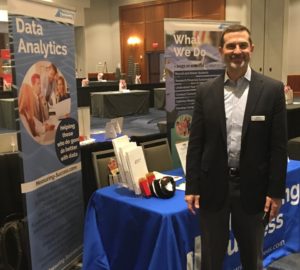By Mark Cross
CEO Measuring Success
Measuring Success was proud to be an exhibitor at The Association of Boarding Schools (TABS) conference in Boston last week. We not only met great people working to improve their schools, but we also learned of the problems they face and spoke with school leaders about how data analytics can help solve some of their biggest challenges.
 At our booth, we talked with heads of school, admissions and business officers (among others) about the ways schools can work smarter by following the evidence the data lays out.
At our booth, we talked with heads of school, admissions and business officers (among others) about the ways schools can work smarter by following the evidence the data lays out.
We talked with one school — with a capacity for nearly 300 students — that is currently opening its doors each school day with about half of the seats occupied. That is unsustainable. They know it. The staff knows it. Their parents know it. Without a near-term course correction, the perception among parents and staff will continue to erode.
We know that a data-driven approach to recruiting, program development and financial best practices can lead schools into the successful futures their students deserve.
How Data Can Help
For schools looking to increase enrollment, we can determine the weakest point in the pipeline, establish the school’s perceived value among parents in the community, identify high likelihood prospective families and define the levers that will drive new families into the school community.
Our approach has three steps:
- Advise school leadership and the board that the only path forward is acknowledging the problem and proactively working toward a solution. Getting stakeholder buy-in is a key component to success in any data analytics project. They may have heard anecdotal solutions from a variety of sources (parents, board members at other schools, school leadership in other towns, etc.). Board members need to be led toward following the evidence based on their own data, not a trail mapped out by well-intentioned storytelling. At issue for most independent schools is working smarter, not harder.
- Identify existing data contained within the school and what additional sources of information need to be gathered. Surveying parents and alumni could be a start to determining perceived value among the school community. As a third party, we are likely to get honest feedback. In the data, we aren’t looking for specific answers. We look for trends in the data. We might gather demographic data from the community to determine if the pool of prospective full pay families has been diminished by competition or economic trends. We might look at tuition pricing, staffing, and school spending to see if we can pinpoint areas of weakness and strength. Finally, we identify families in the community with the highest propensity to consider their school and interview them about their educational requirements and perceptions of the school.
- We analyze the data and begin to formulate, with school leadership, parents and relevant stakeholders, a strategy for moving the school forward. Is it a matter of making investments to modernize the curriculum? Is it targeted marketing to prospective families we identify with a high propensity to consider the school? Is it encouraging current families to not only stay but be champions to prospective families? The path forward for a school with an “empty seats” problem is to follow the data and develop a workable strategy for filling those seats.
Following the data is part one of how we’d work with schools to improve their value proposition. Part two of our working relationships with independent schools circles back to some of the factors addressed during the conference keynote by Travis Roy.
Roy was a graduate of Tabor Academy (Marion, MA) who fulfilled his dream of earning an ice hockey scholarship to Boston University through extremely hard work and sacrifice. In 1995, just 11 seconds into his first-ever college game, Roy was checked headfirst into the boards. He cracked vertebrae in his cervical spine and was left a quadriplegic. He wrote a book about the tragedy in 1998. He has since founded a charity and is a sought-after motivational speaker.
“Sometimes we choose our challenges and sometimes our challenges choose us,” he said. “Who you are at the core is what is going to get you through life’s challenges.”
It was an inspirational thought for attacking the challenges that face our schools. There are challenges to enrollment, recruitment, retention and financial sustainability. But, as Roy said, if you set goals, you need to make them happen.
“Having pride in everything you do can make almost anything possible,” he said.
We believe he is right.
We’d like to thank TABS for putting on a great conference and the schools that attended for taking an interest in talking with us.
If you’d like help with data solutions for your school, feel free to email me for a no-cost consultation.